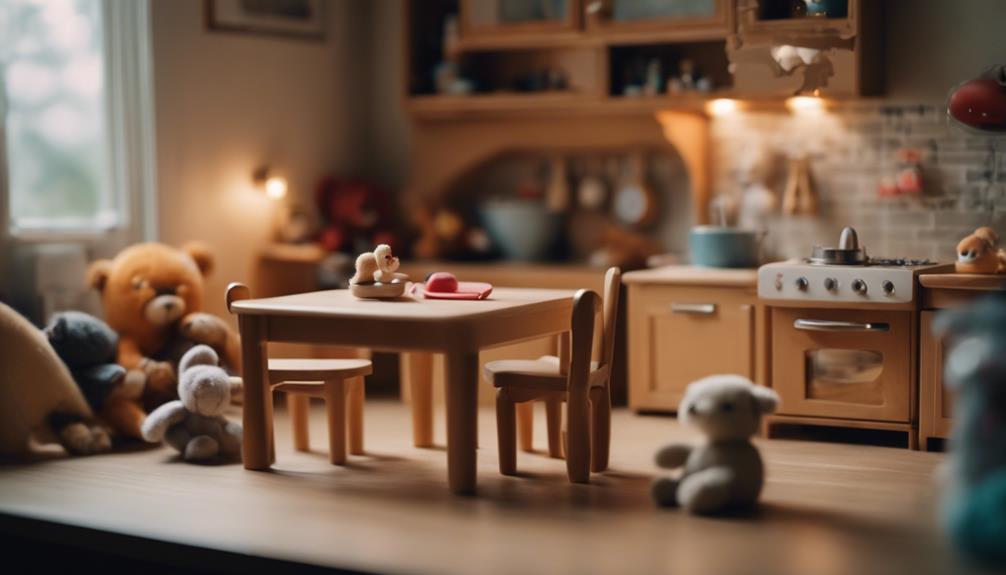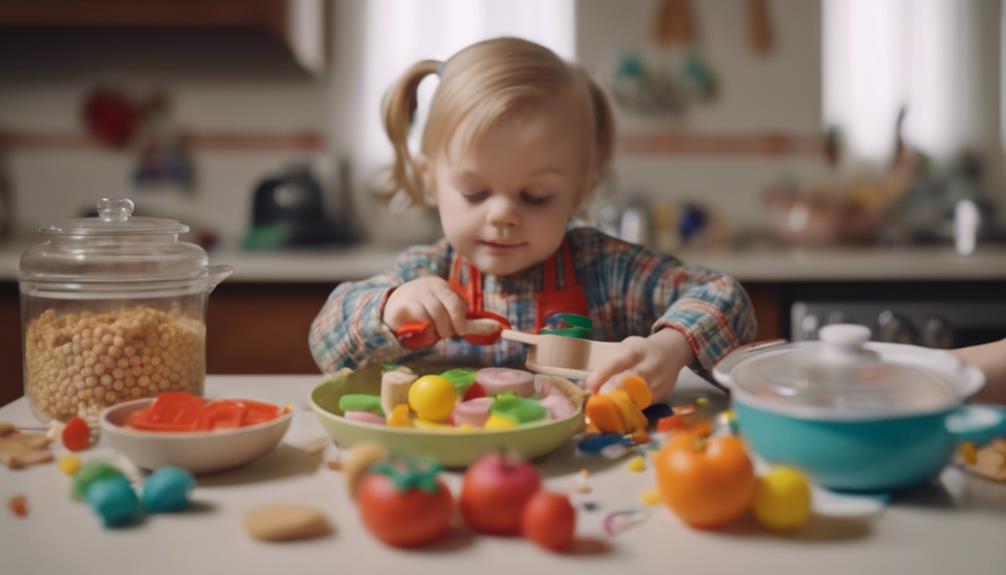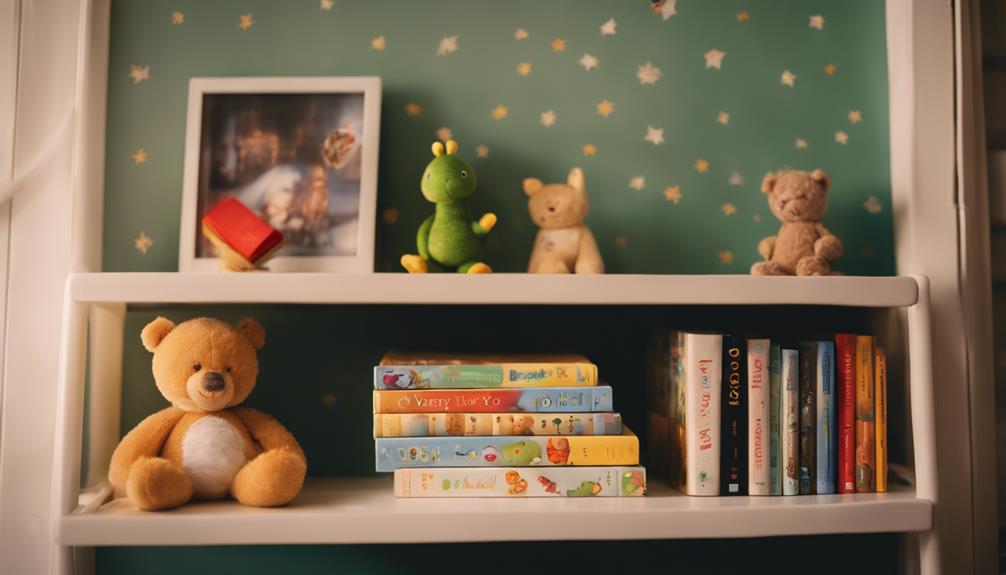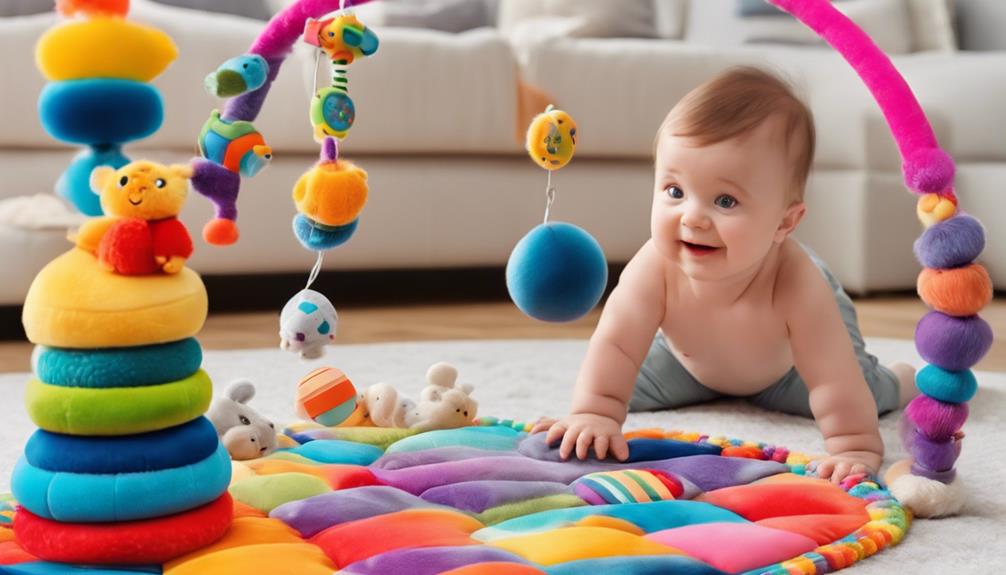Engaging in baby pretend play fosters creativity, problem-solving skills, empathy, and language development in young children. By involving infants in imaginative activities such as role-playing, providing props, and encouraging emotional expression, you are setting the stage for important developmental milestones. Dress-up clothes and open-ended toys help create environments where exploration is encouraged, ultimately boosting social and cognitive skills. As babies explore make-believe worlds, they are not only entertaining themselves but also building crucial skills for future growth. Utilize the benefits of pretend play to enhance your baby’s early development and witness their imagination thrive.
Key Takeaways
- Engage babies in imaginative role-playing activities using props and costumes.
- Encourage storytelling to foster creative thinking and problem-solving skills.
- Stimulate language development through pretend play scenarios and interactions.
- Create play spaces that spark imagination and exploration.
- Enhance social skills and empathy through role exploration and collaborative play.
Benefits of Pretend Play
Engaging in pretend play offers numerous benefits for children's development, including fostering creativity and imagination. When children immerse themselves in pretend scenarios, they tap into their creative potential, imagining worlds and situations beyond reality. Through play, children can explore different roles, settings, and outcomes, honing their problem-solving skills as they navigate through make-believe challenges.
Moreover, pretend play serves as a platform for children to develop empathy and cooperation. By taking on various roles and perspectives, kids learn to understand and relate to others, enhancing their social skills. Through collaborative play scenarios, children practice working together, negotiating roles, and resolving conflicts, fostering a sense of teamwork early on.
Additionally, pretend play stimulates children's language skills, as they engage in conversations, storytelling, and expressing their thoughts and emotions within imaginative contexts. This not only boosts their vocabulary but also improves their communication abilities, laying a strong foundation for their future linguistic development.
Encouraging Pretend Play

To encourage pretend play in babies, engage them in imaginative role-playing activities where they can explore different scenarios and characters. Providing props and costumes will enhance their play experience and inspire creativity.
Imaginative Role-Playing Activities
Encouraging pretend play in children can be achieved through imaginative role-playing activities that allow them to explore various roles and scenarios. Engaging in imaginative play helps children develop emotional skills and understand social and emotional roles by using symbols to represent real-life situations. This type of play not only fosters creativity but also enhances problem-solving abilities, language skills, and teamwork.
Here is a table summarizing the benefits of imaginative role-playing activities:
| Benefits | Description |
|---|---|
| Develop Emotional Skills | Helps children understand and manage their emotions while interacting with others in play. |
| Enhance Social Roles | Allows children to practice different social roles and learn appropriate behaviors in society. |
| Stimulate Creativity | Fosters creativity and imagination as children create scenarios and explore different roles. |
| Improve Problem-Solving | Encourages children to think critically and find solutions to challenges within the play setting. |
| Foster Language Skills | Enhances language development through verbal communication and storytelling during play. |
Creating Play Scenarios
Setting the stage for children to immerse themselves in imaginative and pretend play involves creating play scenarios that ignite their creativity and curiosity. Play scenarios provide a platform for children to explore different roles, settings, and narratives within a make-believe context.
By incorporating props, costumes, and prompts into these scenarios, you can enrich the pretend play experience for children, making it more engaging and stimulating. Engaging in imaginative play scenarios not only nurtures creativity but also helps in developing problem-solving skills and social interactions.
Through these play scenarios, children have the opportunity to enhance their language development and emotional intelligence while having fun and learning simultaneously. Encourage your little ones to partake in various play scenarios, as they can greatly benefit from the rich world of pretend play, opening up a universe of endless possibilities and growth opportunities in a playful and enjoyable manner.
Pretend Play Examples

For pretend play examples, consider scenarios like reverse roles, superheroes on a mission, or playing doctor or vet. Here are some ideas to spark your child's imagination:
- Reverse Roles: Encourage your child to pretend to be the parent while you take on the role of the child. This can help them understand different perspectives and practice empathy.
- Superheroes on a Mission: Let your little one become a superhero with a mission to save the world from imaginary villains. This scenario promotes bravery and problem-solving skills.
- Playing Doctor or Vet: Provide a toy medical kit and let your child play doctor or vet. This role-play scenario enhances their understanding of caring for others and fosters a sense of responsibility.
- Exploring a Fantasy World: Create a magical land together where anything is possible. This imaginative scenario allows your child to develop creative thinking and storytelling skills.
Creating Play Spaces

To create engaging play spaces for your child, consider incorporating open-ended toys, dress-up clothes, and opportunities for imaginative world-building. These elements are essential in fostering a rich environment for pretend play that stimulates your child's imagination and creativity.
By providing open-ended toys such as blocks, dolls, or play dough, you offer your child the freedom to explore different scenarios and create unique narratives. Dress-up clothes and costumes can inspire role-playing and encourage character development, allowing your child to step into various roles and personalities during playtime.
Additionally, enabling opportunities for storytelling and world-building empowers your child to take the lead in crafting imaginative scenarios, enhancing their language skills and social interactions. Real-life scenarios can also serve as creative prompts for pretend play, providing a rich tapestry for your child to explore and learn through play.
Using Dress-Up Clothes

Dress-up clothes enhance children's pretend play experiences by allowing them to fully immerse themselves in different roles and characters. When kids put on costumes and grab props, they step into a world of imagination where they can be anyone or anything.
Here's how using dress-up clothes can benefit your child's pretend play:
- Enhancing Social Skills: Different costumes help kids distinguish roles in group settings, fostering social and emotional skill development.
- Teaching Cooperation: Encouraging dress-up play teaches teamwork, cooperation, and communication skills as children interact while playing different roles.
- Boosting Imagination: Dress-up activities help children embody various mindsets and perspectives, enriching their imaginative play experiences.
- Inspiring Creativity: Using dress-up clothes and props as inspiration can lead to creative and engaging pretend play scenarios, offering endless possibilities for exploration and storytelling.
World Building Activities

Engage your child in world building activities to spark their imagination and creativity through the creation of imaginative scenarios and settings. Pretend play involving world building allows children to explore different roles and rules, fostering effective expression of ideas and enhancing creativity. By using everyday objects in unexpected ways, kids can immerse themselves in these imaginative worlds, further enriching their play experiences.
World building activities aren't just fun; they also play an essential role in language development and symbolic thinking in children. Through engaging in these activities, kids expand their vocabulary, reinforce language skills, and learn to express themselves in creative ways. Encouraging your child to participate in world building scenarios provides them with a platform to ignite their creativity and develop important cognitive skills.
Developing Imagination Through Play

Through imaginative play, toddlers can explore a world of endless possibilities, sparking their creativity and cognitive development. Here are four ways imaginative play helps children develop their imagination and skills:
- Role Exploration:
Imaginative play allows children to take on different roles, such as being a doctor, chef, or astronaut, helping them understand various perspectives.
- Environment Creation:
Children can build imaginary worlds like a magical castle or a bustling city, honing their creative thinking and storytelling abilities.
- Storyline Development:
Pretend play enables children to create narratives, enhancing their problem-solving skills as they navigate through different scenarios.
- Social Interaction:
Engaging in imaginative play with peers fosters social skills like communication, cooperation, and empathy, contributing to their emotional intelligence development.
Frequently Asked Questions
At What Age Do Babies Start Imaginative Play?
Babies typically start engaging in imaginative play around 18-24 months of age. Pretend play involves simple actions like feeding a doll or talking on a toy phone. It's more about exploration and imitation rather than complex scenarios.
What Stage Does a Child Develop Imagination?
Around 18-24 months, your child begins to develop imagination. They explore objects symbolically, engaging in make-believe scenarios. As they grow, their symbolic play becomes more intricate, aiding in understanding and interacting with the world.
Is Pretend Play Imaginative Play?
Yes, pretend play is imaginative play. When you engage in pretend play, you use your creativity to explore different roles and scenarios, allowing you to immerse yourself in make-believe situations and develop social and cognitive skills.
What Type of Development Is Imaginative Play?
Imaginative play fosters cognitive, social, and emotional growth. It enables you to explore various roles and scenarios, enhancing problem-solving skills and communication abilities. Through pretend play, you learn to regulate emotions, build empathy, and improve social interactions.
Conclusion
To sum up, baby pretend play plays a vital role in developing imagination and cognitive skills. By fostering creative play, children can explore new ideas, problem-solving strategies, and social interactions.
Remember, the power of imagination knows no bounds, and through pretend play, your little one can become a superhero, a princess, or even an astronaut.
So, don't underestimate the impact of pretend play on your child's development—it's truly out of this world!










